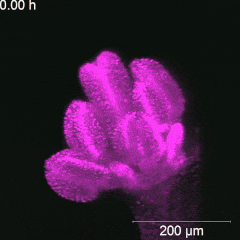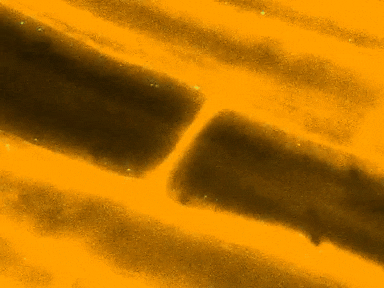20.05.2025
What if you actually could peek inside a flower and watch its sex cells form – live, in real time? Thanks to amazing advances in imaging technology, scientists can now watch inside a flower and see this hidden process as it happens – once impossible vision is now a reality.

From Lenses to Life
Microscopes have come a long way since the 1500s, when a Dutch father-son duo – Hans
and Zacharias Janssen – built the first compound microscope. Soon after, Antonie van
Leeuwenhoek used a single lens to discover microscopic life, which he called animalcules.
Since then, scientists have developed more powerful tools, from electron microscopes to
today’s light sheet fluorescence microscopy (LSFM), which lets us film living cells in 3D
without harming them.
Watching Flowers Grow - Literally
A study led by my colleagues Valuchova et al. (2020), researchers used LSFM to capture
real-time footage of cell division – specifically meiosis, the process by which flowers
create sperm and egg cells. It’s like tuning into a live broadcast from the bedroom of a
flower: chromosomes dance, pollen forms, and even support cells like the tapetum die off
in a carefully timed sequence.
With glowing markers lighting up different parts of the flower, scientists tracked:
Why does the plant´s reproductive drama even matters?
Well, at the heart of these developmental transformations lies the germ cells – cells that
become sperm and eggs. These cells created during meiosis join to form the first cell of a
new organism, which eventually become seeds, the start of new plants. Understanding
how this works helps researchers improve crop fertility, genetic diversity, and food security.
As the climate changes and demands on agriculture grow, insights into reproductive
timing, cellular resilience, and genetic diversity could help engineer better-adapted crops.
With this technology, we’re not just looking at flowers - we’re watching life unfold at its
most fundamental level.
Author: Neha Shukla
- - - - - - - - - - - - - - - - - - - - - - - - - - - - - - -
07.05.2025

Cells are remarkably organized, and while we often picture membrane-bound
organelles like the nucleus or mitochondria, there’s another class of compartments
that’s been hiding in plain sight: biomolecular condensates. These are dynamic,
liquid-like droplets that form via phase separation—a process where certain proteins
and RNAs spontaneously demix from their surroundings.
Unlike traditional organelles, condensates have no membranes. They assemble and
disassemble in response to signals, forming hubs for key processes like RNA
metabolism, stress response, and signalling. Think of them as flexible, transient
"pop-up labs" inside the cell.
The first time I saw P-Bodies move: A moment of awe
I had one of those unforgettable moments at the microscope: watching P-
bodies—tiny, RNA-rich droplets—move in real time. Some raced across cells, others
drifted slowly. Each tissue layer revealed a different pattern—different numbers,
sizes, and movement dynamics. This was my first encounter with phase-separated
compartments, and now, after more than five years of working with P-bodies, I still
find myself captivated every time I see them. These structures form without
membranes and yet organize key processes like RNA decay and storage.
What struck me most was their dynamicity—they were in constant motion, either
running or wobbling around. I could see, in real time, how alive and responsive these
structures were. That experience sparked a deep curiosity in me. Why are some
moving fast and others slow? What controls their behaviour? What are they doing?
That simple observation opened a floodgate of questions, pulling me deeper into the
world of condensates.
P-bodies are one example of a broader class of biomolecular condensates that
organize cellular functions using physical principles like phase separation. They’re
ancient, found across all life forms, and may have played a role in prebiotic
evolution—organizing molecules before membranes even existed.
If you’re curious about the liquid life inside cells—or just like watching molecules
dance—this is a world worth exploring. Sometimes science begins not with a
hypothesis, but with wonder.